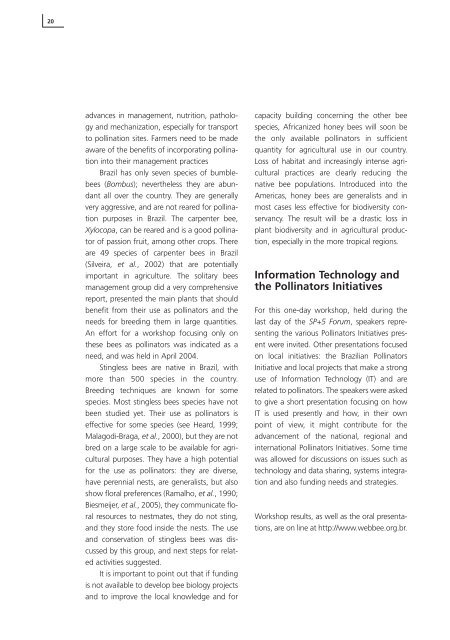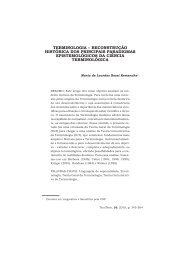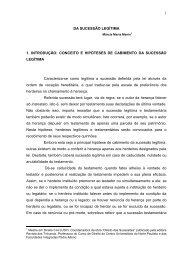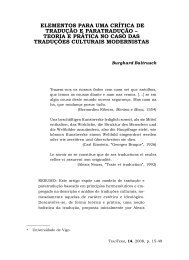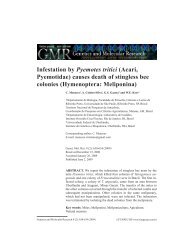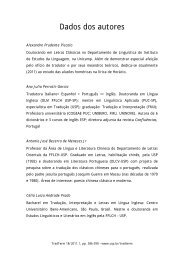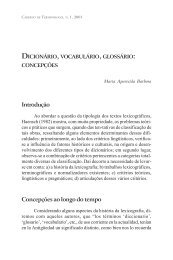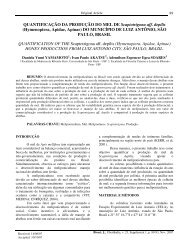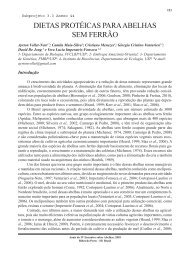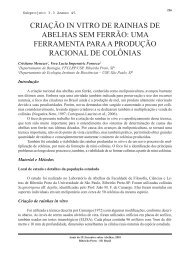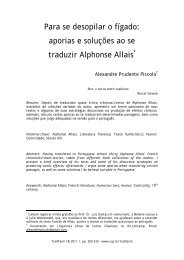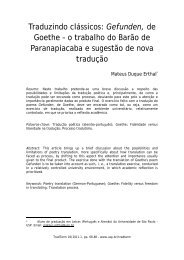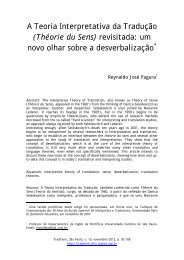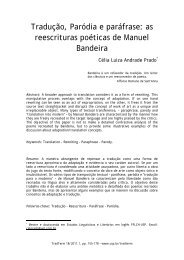Bees as pollinators in Brazil - USP
Bees as pollinators in Brazil - USP
Bees as pollinators in Brazil - USP
Create successful ePaper yourself
Turn your PDF publications into a flip-book with our unique Google optimized e-Paper software.
20<br />
advances <strong>in</strong> management, nutrition, pathology<br />
and mechanization, especially for transport<br />
to poll<strong>in</strong>ation sites. Farmers need to be made<br />
aware of the benefits of <strong>in</strong>corporat<strong>in</strong>g poll<strong>in</strong>ation<br />
<strong>in</strong>to their management practices<br />
<strong>Brazil</strong> h<strong>as</strong> only seven species of bumblebees<br />
(Bombus); nevertheless they are abundant<br />
all over the country. They are generally<br />
very aggressive, and are not reared for poll<strong>in</strong>ation<br />
purposes <strong>in</strong> <strong>Brazil</strong>. The carpenter bee,<br />
Xylocopa, can be reared and is a good poll<strong>in</strong>ator<br />
of p<strong>as</strong>sion fruit, among other crops. There<br />
are 49 species of carpenter bees <strong>in</strong> <strong>Brazil</strong><br />
(Silveira, et al., 2002) that are potentially<br />
important <strong>in</strong> agriculture. The solitary bees<br />
management group did a very comprehensive<br />
report, presented the ma<strong>in</strong> plants that should<br />
benefit from their use <strong>as</strong> <strong>poll<strong>in</strong>ators</strong> and the<br />
needs for breed<strong>in</strong>g them <strong>in</strong> large quantities.<br />
An effort for a workshop focus<strong>in</strong>g only on<br />
these bees <strong>as</strong> <strong>poll<strong>in</strong>ators</strong> w<strong>as</strong> <strong>in</strong>dicated <strong>as</strong> a<br />
need, and w<strong>as</strong> held <strong>in</strong> April 2004.<br />
St<strong>in</strong>gless bees are native <strong>in</strong> <strong>Brazil</strong>, with<br />
more than 500 species <strong>in</strong> the country.<br />
Breed<strong>in</strong>g techniques are known for some<br />
species. Most st<strong>in</strong>gless bees species have not<br />
been studied yet. Their use <strong>as</strong> <strong>poll<strong>in</strong>ators</strong> is<br />
effective for some species (see Heard, 1999;<br />
Malagodi-Braga, et al., 2000), but they are not<br />
bred on a large scale to be available for agricultural<br />
purposes. They have a high potential<br />
for the use <strong>as</strong> <strong>poll<strong>in</strong>ators</strong>: they are diverse,<br />
have perennial nests, are generalists, but also<br />
show floral preferences (Ramalho, et al., 1990;<br />
Biesmeijer, et al., 2005), they communicate floral<br />
resources to nestmates, they do not st<strong>in</strong>g,<br />
and they store food <strong>in</strong>side the nests. The use<br />
and conservation of st<strong>in</strong>gless bees w<strong>as</strong> discussed<br />
by this group, and next steps for related<br />
activities suggested.<br />
It is important to po<strong>in</strong>t out that if fund<strong>in</strong>g<br />
is not available to develop bee biology projects<br />
and to improve the local knowledge and for<br />
capacity build<strong>in</strong>g concern<strong>in</strong>g the other bee<br />
species, Africanized honey bees will soon be<br />
the only available <strong>poll<strong>in</strong>ators</strong> <strong>in</strong> sufficient<br />
quantity for agricultural use <strong>in</strong> our country.<br />
Loss of habitat and <strong>in</strong>cre<strong>as</strong><strong>in</strong>gly <strong>in</strong>tense agricultural<br />
practices are clearly reduc<strong>in</strong>g the<br />
native bee populations. Introduced <strong>in</strong>to the<br />
Americ<strong>as</strong>, honey bees are generalists and <strong>in</strong><br />
most c<strong>as</strong>es less effective for biodiversity conservancy.<br />
The result will be a dr<strong>as</strong>tic loss <strong>in</strong><br />
plant biodiversity and <strong>in</strong> agricultural production,<br />
especially <strong>in</strong> the more tropical regions.<br />
Information Technology and<br />
the Poll<strong>in</strong>ators Initiatives<br />
For this one-day workshop, held dur<strong>in</strong>g the<br />
l<strong>as</strong>t day of the SP+5 Forum, speakers represent<strong>in</strong>g<br />
the various Poll<strong>in</strong>ators Initiatives present<br />
were <strong>in</strong>vited. Other presentations focused<br />
on local <strong>in</strong>itiatives: the <strong>Brazil</strong>ian Poll<strong>in</strong>ators<br />
Initiative and local projects that make a strong<br />
use of Information Technology (IT) and are<br />
related to <strong>poll<strong>in</strong>ators</strong>. The speakers were <strong>as</strong>ked<br />
to give a short presentation focus<strong>in</strong>g on how<br />
IT is used presently and how, <strong>in</strong> their own<br />
po<strong>in</strong>t of view, it might contribute for the<br />
advancement of the national, regional and<br />
<strong>in</strong>ternational Poll<strong>in</strong>ators Initiatives. Some time<br />
w<strong>as</strong> allowed for discussions on issues such <strong>as</strong><br />
technology and data shar<strong>in</strong>g, systems <strong>in</strong>tegration<br />
and also fund<strong>in</strong>g needs and strategies.<br />
Workshop results, <strong>as</strong> well <strong>as</strong> the oral presentations,<br />
are on l<strong>in</strong>e at http://www.webbee.org.br.


